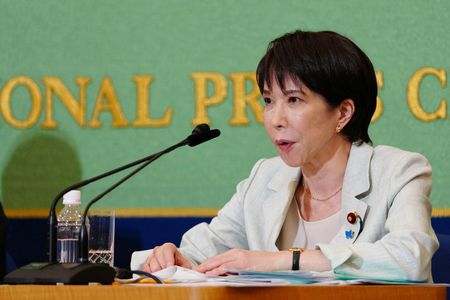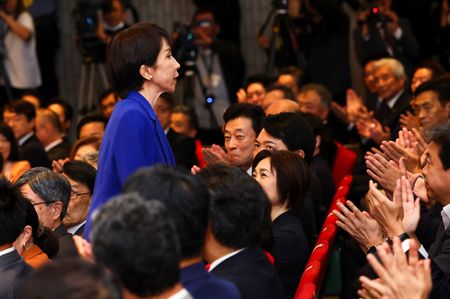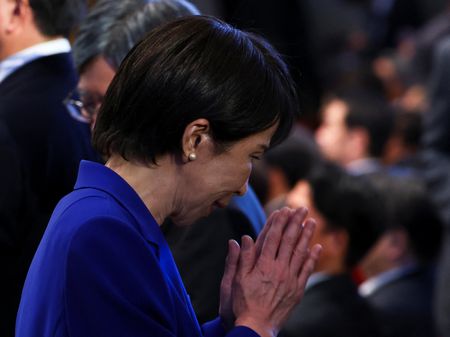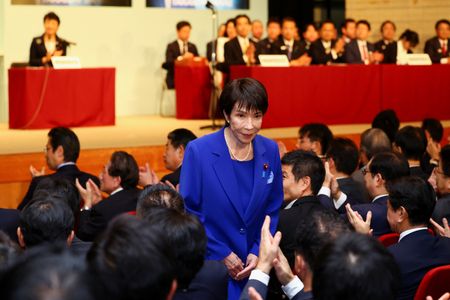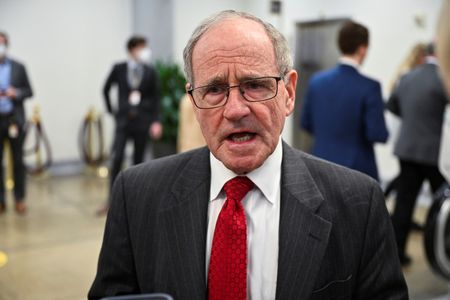By Kantaro Komiya
TOKYO (Reuters) -In her campaign to become Japan’s first female prime minister, Sanae Takaichi made a bold promise to narrow the country’s wide gender gap in politics and lift the number of women in cabinet to a par with socially progressive Nordic countries.
Now that she has shattered the glass ceiling to be chosen leader of the ruling party on Saturday – setting her on course to emulate her hero Margaret Thatcher, Britain’s first female premier – Takaichi must try to deliver on promises her party has struggled to keep.
“The emergence of a single female leader alone may not drastically improve women’s standing in politics,” said Tohko Tanaka, a gender studies professor at the University of Tokyo, noting it was 26 years after Thatcher’s premiership before Britain had its second female leader, Theresa May.
FEW WOMEN LAWMAKERS FOR TAKAICHI CABINET
Japan’s next prime minister “must tackle gender issues with a long-term perspective, amid severe labour shortages and the alarmingly inadequate inclusion of women,” Tanaka said.
Japan ranked 118 out of 148 countries in the World Economic Forum’s latest Global Gender Gap Report, the lowest among the Group of Seven industrial powers.
While gender equality was not a top issue in the Liberal Democratic Party’s election campaign that focused on tackling inflation and rule-breaking foreigners, Takaichi’s promises to form a cabinet with women’s representation “not particularly lower than Nordic countries” stood out.
“I wouldn’t appoint women just because they’re women,” she told a party rally last week. “But the plan is to pick far more women who are capable and willing to serve the nation.”
Just 10% of outgoing Prime Minister Shigeru Ishiba’s 20 cabinet members are women, while its highest female representation was just above a quarter. Nordic governments range from Denmark’s 36% to Finland’s 61% female ministers.
To fill her cabinet, Takaichi has a relatively small pool of female lawmakers to draw from, although non-politicians are allowed to head government ministries. Only 13% of the LDP’s lawmakers across both houses are women, well short of the party’s target of 30% by 2033 – a goal already trailing a government target.
PROMISES UNFULFILLED
Past initiatives to close Japan’s gender gap have delivered mixed results.
Former premier Shinzo Abe, Takaichi’s mentor, pulled more women into the workforce through his “womenomics” initiatives, but critics say progress has been too slow, especially for executive roles.
In 2020, the government pushed back its deadline of having women in at least 30% of leadership posts across society by a decade to 2030.
Takaichi also proposes measures such as establishing women’s health centres nationwide, but her broader conservative policies have damaged her support among some women, polls show.
For example, she has defended legal restrictions that married couples must use a single surname, which in practice means wives overwhelmingly take their husbands’ names and which critics say disproportionately affects women’s careers. Conservatives regard the current law as indispensable to family unity.
The centre-right LDP faces a challenge from Sanseito, an upstart far-right party whose leader has criticised gender equality policies for contributing to Japan’s record-low birthrate, a claim resonating in some anti-establishment movements globally.
(Reporting by Kantaro Komiya in Tokyo; Additional reporting by Louise Rasmussen in Copenhagen; Editing by John Geddie and William Mallard)

